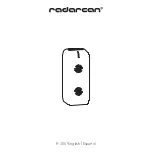
© Danfoss A/S (RC-CMS / HBS), 03 - 2005
RI4XS152
3
Installation
Design
See fig. 1
1. Valve body
1a and 1b. Channels in valve body (1)
10. Valve spindle
11. Throttle cone
12. Valve seat
21a. Equalizing hole in servo piston (24)
22. Locking ring
24. Servo piston
24a. Gasket
30. Bottom cover
33. Strainer
36. Bottom plug
40. Cover
40a, b, c and d. Channels in cover (40)
44. Pressure gauge connection
60. Manual operating spindle
S I, S II and P. Pilot valve connections
Refrigerants
Applicable to all common non-flammable
refrigerants, including R717 and non-
corrosive gases/liquids dependent on
sealing material compatability.
Flammable hydrocarbons are not recom-
mended. The valve is only recommended
for use in closed circuits. For further
information please contact Danfoss.
Temperature range
PM: –60/+120°C (–76/+248°F)
Pressure range
PM: The valves are designed for a max.
working pressure of 28 bar g (406 psi g).
Technical data
The PM 1 can be used in suction, liquid, hot-
gas and liquid/vapour lines.
The PM 1 regulates the flow of the medium
by modulation or on/off function,
depending on the control impulse from the
screwed on pilot valves.
The PM 3 has three connections for pilot
valves: two in series, marked "S I" and "S II",
and one in parallel with these two, marked
"P", figs. 3 and 4.
If only two pilot valves are necessary
for the function required, the third pilot
connection must be sealed with a blanking
plug (see fig. 4). A blanking plug is supplied
with the valve.
Opening differential pressure (
∆
p)
The PM main valve requires a minimum
opening differential pressure of 0.07 bar
(1 psi) to begin to open and 0.2 bar (2.8 psi)
to be completely open.
Note: The valve opens when differential
pressure against the direction of flow
occurs.
Installation
Flange set for the PM is delivered separately.
The valve must be installed with the arrow
in the direction of the flow and the top
cover upwards (fig. 2). The top cover can be
rotated 4 X 90° in relation to the valve body.
The valve is fitted with a spindle for manual
opening.
If an external pilot valve is used, the pilot
line must be connected to the upper side of
the main line so that any dirt and oil from
the plant will not find its way into the pilot
line.
If the PM 1 is to be used as a solenoid valve
in a liquid line, external control pressure
cannot be recommended because it can
cause liquid hammer.
The valve is designed to withstand a high
internal pressure. However, the piping
system should be designed to avoid liquid
traps and reduce the risk of hydraulic
pressure caused by thermal expansion. It
must be ensured that the valve is protected
from pressure transients like “liquid
hammer” in the system.
Welding
If using welding flanges, only materials and
welding methods, compatible with the
flange material must be welded to the
flanges. The flanges should be cleaned
internally to remove welding debris on
completion of welding and before the valve
is inserted.
The valve housing and flanges must be
free from stresses (external loads) after
installation.
PM valves must not be mounted in systems
where the outlet side of the valve is open
to atmosphere. The outlet side of the valve
must always be connected to the system
or properly capped off, for example with a
welded-on end plate.
Colours and identification
The PM valves are Zinc-Chromated in the
factory. If further corrosion protection is
required, the valves can be painted.
Precise identification of the valve is made
via the ID plate on the top cover. The
external surface of the valve housing must
be prevented against corrosion with a
suitable protective coating after installation
and assembly.
Protection of the ID plate when repainting
the valve is recommended.
Maintenance
Service
The PM valves are easy to dismantle and
most of its parts are replaceable. When the
bottom cover is removed, the strainer can
be taken out for cleaning.
Do not open the valve while the valve is still
under pressure.
Check that the O-ring has not been
damaged.
Check that the spindle is free of
scratches and impact marks.
If the teflon ring has been damaged, the
parts must be replaced.
Assembly
Remove any dirt from the body before the
valve is assembled. Check that all channels
in the valve are not blocked with articles or
similar.
ENGLISH
Tightening (fig. 6)
Tightening torques
See table I.
Use only original Danfoss parts, including
packing glands, O-rings and gaskets for
replacement. Materials of new parts are
certified for the relevant refrigerant.
In cases of doubt, please contact Danfoss.
Drawings are only for illustration, not for
dimensioning or construction.
Danfoss accepts no responsibility for
errors and omissions. Danfoss Industrial
Refrigeration reserves the right to make
changes to products and specifications
without prior notice.


























